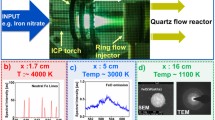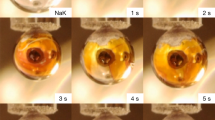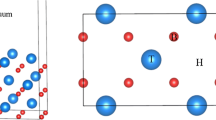Abstract
The reactions of water vapor and oxygen with liquid uranium were studied by modulated molecular-beam mass spectrometric methods. Equivalent pressures of the reactant fluxes on the surface ranged from 6×10 −6 to 2×10−4 torr. Temperatures up to 1570 K were investigated. The metal surface was kept clean during reaction by mechanical removal of the oxide formed with a tungsten needle. For the clean liquid uranium surface, a water reaction probability of ∼0.4 was deduced both from measurement of the reaction-product hydrogen signal and by the temperature dependence of the scattered reactant signal. Based solely on the latter measure, a reaction probability of 0.6 was estimated for oxygen. The reaction probabilities on the clean surface were temperatureindependent. They decreased as the coverage of the surface by islands of oxide increased and, for water, appeared to approach a value of 0.08 for a surface completely covered with an oxide estimated to be 500 Å thick. Bombardment of the surface during reaction with argon ions produced an increase in the reactivity on solid uranium but had a negligible effect on the reaction probability for the liquid.
Similar content being viewed by others
References
J. I. Davis, J. Z. Holtz, and M. L. Spaeth, Status and Prospects for Laser Isotope Separation, Laser Focus, p. 49, Sept. 1982.
D. R. Olander, R. H. Jones, W. J. Siekhaus, and J. A. Schwarz,J. Vac. Sci. Technol. 9, 1429 (1972).
A. J. Machiels and D. R. Olander,Surf. Sci. 65, 325 (1977).
M. Balooch, D. R. Olander, and W. J. Siekhaus,J. Phys. Chem. 88, 3521 (1985).
L. J. Kieffer,JILA Report No. 13 (University of Colorado Press, Boulder, 1973).
M. Asano, H. Kimura, and K. Kubo,J. Mass. Spect. 27, 157 (1979).
UTI Quadrupole Mass Spectrometer Manual, 100C-02 (1977).
H. Harrison, D. G. Hummer, and W. L. Fite,J. Chem. Phys. 41, 2567 (1964).
C. A. Colmenares, inProgress in Solid State Chemistry. Vol. 9. J. O. McCaldin and G. Somojai, eds. (Pergamon Press, London, 1975), p. 139.
W. McLean II and W. J. Siekhaus,Reaction of Water with a Clean Liquid Uranium Surface, UCRL-92753, Rev. 1 (1985).
A. Ullman, R. Acharya, and D. R. Olander,J. Nucl. Mater. 51, 277 (1974).
C. A. Colmenares, inProgress in Solid State Chemistry. Vol. 15. G. M. Rosenblatt and W. L. Worrell, eds. (Pergamon Press, London, 1985), p. 257.
S. C. McNevin,J. Vac. Sci. Technol. B4, 1203 (1986).
Author information
Authors and Affiliations
Rights and permissions
About this article
Cite this article
Balooch, M., Olander, D.R. & Siekhaus, W.J. Reaction of water vapor and oxygen with liquid uranium. Oxid Met 28, 195–211 (1987). https://doi.org/10.1007/BF00656707
Received:
Issue Date:
DOI: https://doi.org/10.1007/BF00656707




